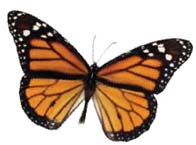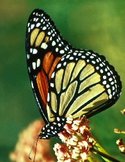Monarch Butterflies
|
|
| Monarch butterfly | ||||||||||||||||
|---|---|---|---|---|---|---|---|---|---|---|---|---|---|---|---|---|
 | ||||||||||||||||
| Scientific classification | ||||||||||||||||
| ||||||||||||||||
| Binomial name | ||||||||||||||||
| Danaus plexippus (Linnaeus, 1758) |
The Monarch butterfly (Danaus plexippus) is a well-known North American butterfly. Its wings feature an easily recognizable orange and black pattern. The females have darker veins on their wings, and the males have a spot in the center of each hindwing from which pheromones are released.
Monarchs are especially noted for their lengthy annual migration. They make massive southward migrations from August through October. A northward migration takes place in the spring. Female Monarch butterflies deposit eggs for the next generation during these migrations. The population east of the Rocky Mountains overwinters in [[Michoacᮝ], Mexico, and the western population overwinters in various sites in central coastal California, United States, notably in Pacific Grove and Santa Cruz. The length of these journeys far exceeds the lifetime of any given butterfly (lives 4 days as egg, 2 weeks as caterpillar, 10 days as chrysalis, and 2-6 weeks as a butterfly). How the species manages to return to the same overwintering spots over a gap of several generations remains a mystery. This is one of the few insects to manage transatlantic crossings. A few Monarchs turn up in the far southwest of Great Britain in any year when the wind conditions are right.
Monarch_flock.jpg
The life cycle of a Monarch butterfly includes a change of form called complete metamorphosis. This process goes through four radically different stages. First, as mentioned above, the eggs are laid by the females during migration. Second, the eggs hatch, revealing worm-like larva, the caterpillars. The caterpillars consume their egg cases, then feed on milkweed, and sequester substances called cardenolides, related to the cardiac glycoside digitalis. The amount accumulated depends on the level present in the milkweed. This accumulation makes the adult butterfly distasteful and poisonous to Blue Jays and other would-be predators, and many such animals avoid consuming it. This defense is shared by the similarly distasteful (and similar-appearing) viceroy, in an example of Mullerian mimicry.
During the caterpillar stage, Monarchs store energy in the form of fat and nutrients to carry them through the non-feeding pupa stage. The third stage is the pupa, or chrysalis. The caterpillar attaches itself to a lump of material secreted on a twig or leaf. It hangs upside down in the shape of a 'J', and then molts, leaving itself encased in an articulated green exoskeleton. At this point, hormonal changes occur, leading to the development of a butterfly. Fourth, the mature butterfly emerges after about two weeks.
Monarchrsh3.jpg
The monarch butterfly is the state insect of Texas and the state butterfly of Minnesota. It was nominated in 1989 as the national insect of the United States, and is the national insect of Canada. The monarch's name and color were also the inspiration for the name and home strip of the Michoacᮭbased CA Monarcas Morelia professional football team.
Recent illegal deforestation of the Monarch's overwintering grounds have led to a drastic reduction in the butterfly's population. Efforts to classify it as a protected species and to restore its habitat are underway.

